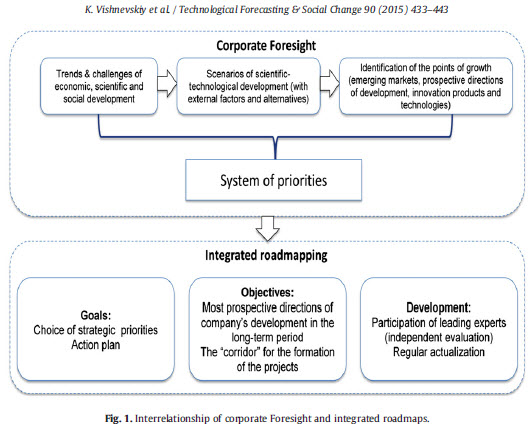5 July 2015:
Vishnevskiy, Karasev & Meissner (2015) conducted over 40 project implementations and interviews with Russian companies in the oil & gas, energy and aviation sectors to build an understanding of contemporary approaches to foresight. In their research, they demonstrate the important link between foresight and action planning (or “roadmapping”) for corporate strategy building and innovation management.
The authors describe two main approaches of roadmapping:
1) The market pull approach which utilises market demand as the major driver of R&D; and
2) The technology push approach which starts with the most important technologies and tries to identify the market needs that could address the challenges arising from the use of the new technologies.
The linking of corporate foresight and integrated roadmapping as visualised below supports organisations to: a) identify the potential for new product development, b) introduce new processes in corporate activities, c) optimise decision-making, d) develop strategic priorities, e) identify the main risks inherent in the organisation, and f) identify the options for changing market conditions.
Fig. 1. Interrelationship of Corporate Foresight and Integrated Roadmaps (Vishnevskiy, Karasev & Meissner 2015)
The authors present an eight step framework to develop long-term opportunities and build and prioritise roadmaps:
A: Corporate foresight for the development of long-term system of priorities
– Step 1: Preparation (creation of an expert group);
– Step 2: Visioning (detection of trends and drivers for subject field/s, and elaboration of future vision);
– Step 3: Analysis (technology push and market pull analysis, estimation of competitive advantages for prospective
product groups); and
– Step 4: Prioritising (creation and validation of priorities system).
B: Roadmap for priority realisation
– Step 1: Preparation (creation of expert group (with participation of experts from foresight) for priority directions
of subject field/s);
– Step 2: Analysis/Scenarios (deep analysis of scenarios, challenges, consumer requirements, technology supply, trends and drivers for priority directions);
– Step 3: Prioritising (analysis of products features against future consumer requirements, benchmarking against external innovations and new technologies); and
– Step 4: Implementation (roadmap visualisation and description, definition and validation of strategic R&D programme).
The above framework was tested and implemented in over 40 large Russian companies during 2008 to 2013. The authors conclude that “the use of integrated roadmaps as a final outcome of corporate foresight helps to develop a coherent vision for the company’s long-term development at the level of all key stakeholders. A consolidated approach to the method of selection of target projects, adoption and execution of strategic decisions is realised in the sphere of investments and innovation development. Corporate foresight based integrated roadmaps contain the information necessary to make informed strategic decisions including new opportunities for achieving innovation based corporate development goals”.
Reference:
Vishnevskiy, Konstantin; Karasev, Oleg & Meissner, Dirk 2015, „Integrated roadmaps and corporate foresight as tools of innovation management: The case of Russian companies”, Technological Forecasting and Social Change, vol. 90, part B, January, pp. 433–443.
Link to full text article:
http://www.sciencedirect.com/science/article/pii/S0040162514001322

